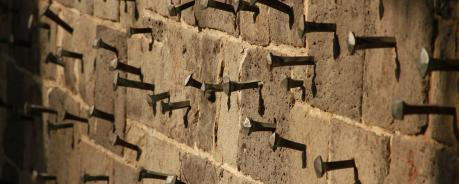AIDS Memorial

In April 1994, more than 60,000 people in Germany were infected with HIV. In Frankfurt alone, 538 men and women died of AIDS around that time. Frankfurt led the statistics then, together with Berlin, as it does today. With the appearance of AIDS, a whole attitude to life changed; sex, illness and death were suddenly mentioned in the same breath. And unfortunately, this often meant saying goodbye. But in which place? There are numerous churches and cemeteries in Frankfurt, and for some these places were sufficient. But for many this was not the case, whether they were gay, lesbian, drug users, sex workers, or simply people with HIV and AIDS.
Many of those who died of AIDS are and were buried near their families, others ended up in so-called ‘paupers' graves’. Mourners would then have a day's work ahead of them to visit all the graves of friends and acquaintances. So, it was and is necessary to create places where we feel properly taken care of with our grief. This was the starting point for the project AIDS Memorial in 1994, initiated by Rüdiger Anhalt and other fellow campaigners from ACT UP, such as Stefan Majer, at that time still from AIDS-Hilfe Frankfurt: A new place of mourning was to be created that was close to the scene, the Peterskirchhof seemed ideal and the local council, the parish, the office for the protection of historical monuments and the horticultural office agreed to the project.
The square was designed according to Tom Fecht's ‘Injured Love’ concept. The implementation of the concept was successful at the time because the necessary amount of 17,000 Marks was raised entirely from donations from the public, especially from the gay scene.
The memorial consists of the elements writing and nails. The inscription ‘Verletzte Liebe’ (Wounded love) was set into the sandstone wall of the churchyard in golden letters and is taken up again elsewhere with the dedication ‘a l'amour blesse 1994’. Furthermore, nails were and are embedded in the wall for each person who died of AIDS in Frankfurt. The nails are deliberately not specifically marked. According to Fecht: “Each nail also stands for the death of the anonymous victims and injuries that are associated with each new illness: Loneliness, discrimination, fear, loss of trust, loss of friends.”
In addition to their symbolic function (the nails take up the religious motif of the crucifixion, the dishonouring by torturous execution was always also the death sentence for people of other convictions, other beliefs, other attitudes and lifestyles), the nails also have a practical function, e.g. at actions and commemorative events for fastening personal mementos, flowers, banners, etc.
Every year on World AIDS Day, when the funeral march comes through Frankfurt city centre and ends at the memorial, the names of the dead of the past year are read out, and three more nails are symbolically hammered into the wall. The commemoration of the dead is further enlivened on this evening with red roses.
AHF – AIDS-Hilfe Frankfurt e. V.
Share on




